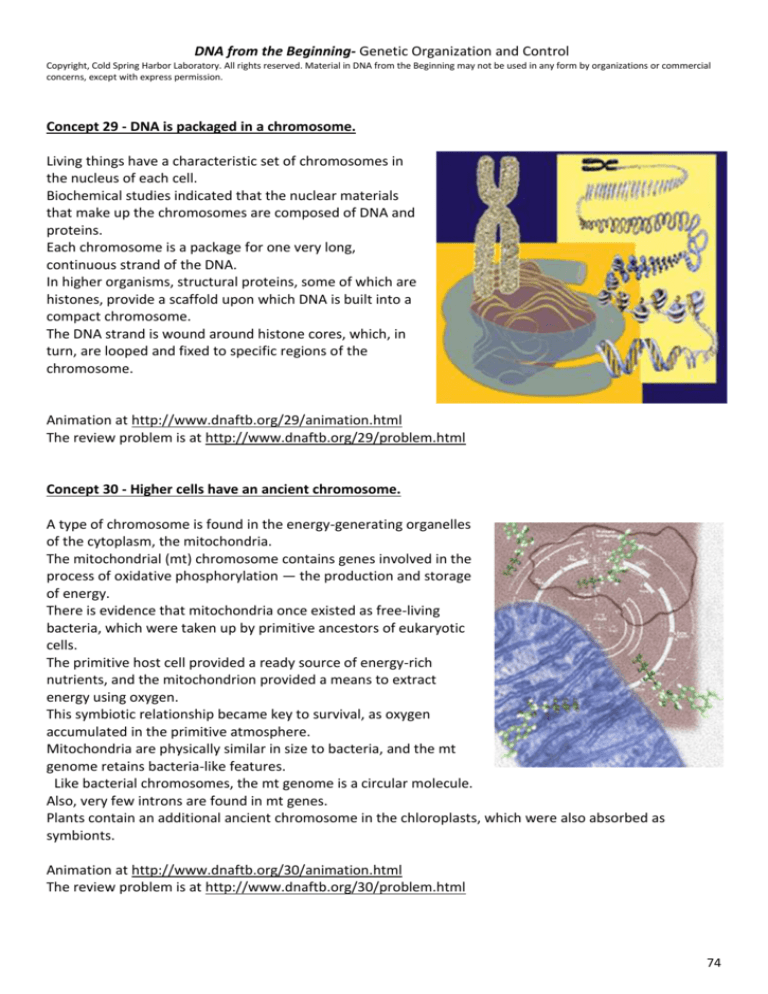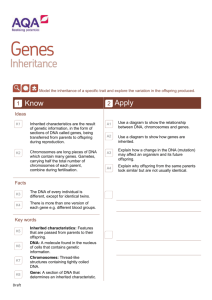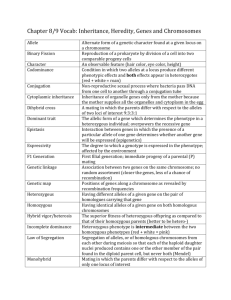
DNA from the Beginning- Genetic Organization and Control
Copyright, Cold Spring Harbor Laboratory. All rights reserved. Material in DNA from the Beginning may not be used in any form by organizations or commercial
concerns, except with express permission.
Concept 29 - DNA is packaged in a chromosome.
Living things have a characteristic set of chromosomes in
the nucleus of each cell.
Biochemical studies indicated that the nuclear materials
that make up the chromosomes are composed of DNA and
proteins.
Each chromosome is a package for one very long,
continuous strand of the DNA.
In higher organisms, structural proteins, some of which are
histones, provide a scaffold upon which DNA is built into a
compact chromosome.
The DNA strand is wound around histone cores, which, in
turn, are looped and fixed to specific regions of the
chromosome.
Animation at http://www.dnaftb.org/29/animation.html
The review problem is at http://www.dnaftb.org/29/problem.html
Concept 30 - Higher cells have an ancient chromosome.
A type of chromosome is found in the energy-generating organelles
of the cytoplasm, the mitochondria.
The mitochondrial (mt) chromosome contains genes involved in the
process of oxidative phosphorylation — the production and storage
of energy.
There is evidence that mitochondria once existed as free-living
bacteria, which were taken up by primitive ancestors of eukaryotic
cells.
The primitive host cell provided a ready source of energy-rich
nutrients, and the mitochondrion provided a means to extract
energy using oxygen.
This symbiotic relationship became key to survival, as oxygen
accumulated in the primitive atmosphere.
Mitochondria are physically similar in size to bacteria, and the mt
genome retains bacteria-like features.
Like bacterial chromosomes, the mt genome is a circular molecule.
Also, very few introns are found in mt genes.
Plants contain an additional ancient chromosome in the chloroplasts, which were also absorbed as
symbionts.
Animation at http://www.dnaftb.org/30/animation.html
The review problem is at http://www.dnaftb.org/30/problem.html
74
Concept 31 - Most DNA does not encode protein.
In most cases when DNA is extracted from living cells, the
proteins (including histones) are dissolved away.
This results in long strands of naked DNA, which keep their
genetic information.
So it is useful to visualize a chromosome as a continuous strand
of DNA.
Arrayed along the DNA strand are the genes, regions whose
sequences carry the genetic code for making specific proteins.
The genes of bacteria are tightly packed together; virtually all the
DNA encodes proteins.
A large proportion of eukaryotic DNA is made of repeated
sequences that do not encode proteins.
Long non-coding sequences — or intergenic regions — separate
relatively infrequent "islands" of genes.
Numerous non-coding sequences — introns — are also found within genes, interrupting the proteincoding regions, or exons.
It is estimated that only about one percent of human DNA encodes protein.
About 25% make up genes and regulatory elements.
Animation at http://www.dnaftb.org/31/animation.html
The review problem is at http://www.dnaftb.org/31/problem.html
Concept 32 - Some DNA can jump.
In the 1950s, Barbara McClintock showed that certain DNA
fragments, termed transposons, can be activated to transpose
("jump") from one position on a chromosome to another.
She thought that transposition provides a means to rapidly
reorganize genes in response to environmental stress.
McClintock's work was based entirely on observation of
chromosomes and genetic crosses.
This work led to the modern concept of chromosomes as
dynamic, changing structures.
Alu is an example of a so-called "jumping gene" - a transposable
DNA sequence that "reproduces" by copying itself and inserting
into new chromosome locations.
http://www.dnalc.org/resources/animations/alu.html
Animation at http://www.dnaftb.org/32/animation.html
The review problem is at http://www.dnaftb.org/32/problem.html
75
Concept 33 - Genes can be turned on and off.
Organisms can regulate gene expression.
French researchers studied gene regulation using bacteria.
When lactose is available, E. coli turn on a set of genes to
metabolize the sugar.
Lactose removes an inhibitor from the DNA.
Removing the inhibitor turns on gene production.
The gene that produces the inhibitor is a regulatory gene.
Cells not only have genetic plans for structural proteins
within their DNA, they also have a genetic regulatory
program for expressing those plans.
Animation at http://www.dnaftb.org/33/animation.html
The review problem is at http://www.dnaftb.org/33/problem.html
Concept 34 - Genes can be moved between species.
The genetic code is universal.
The polymerases of one organism can accurately transcribe a
gene from another organism.
For example, different species of bacteria obtain antibiotic
resistance genes by exchanging small chromosomes called
plasmids.
1970s - researchers used this type of gene exchange to move a
"recombinant" DNA molecule between two different species.
1980s, other scientists adapted the technique and spliced a
human gene into E. coli to make recombinant human insulin
and growth hormone.
Recombinant DNA technology — genetic engineering — has
made it possible to gain insight into how genes work.
In cases where it is impractical to test gene function using animal models, genes can first be expressed in
bacteria or cell cultures.
Similarly, the phenotypes of gene mutations and the efficacy of drugs and other agents can be tested using
recombinant systems.
Cohen and Boyer's recombinant DNA technique "created" the biotech industry.
In 1974, the technique was submitted for patenting, and in 1976, the first biotech company, Genentech
Inc., was established based on recombinant DNA technology.
Animation at http://www.dnaftb.org/34/animation.html
The review problem is at http://www.dnaftb.org/34/problem.html
76
Concept 35 - DNA responds to signals from outside the cell.
Growth and development require that cells communicate with each other
and react to signals that come from other parts of the body.
Chemicals, eg. hormones released by various glands travel throughout the
body to stimulate the growth of certain cell types.
Cells capable of being stimulated by a particular hormone possess a specific
receptor anchored in the cell membrane.
The binding of a hormone to its receptor initiates a series of molecular
transformations, called signal transduction, that relay the growth signal
through the cell.
First, the receptor transduces the signal through the cell membrane to the
internal membrane surface, where it activates protein "messengers."
These messengers are part of and initiate a cascade of chemical reactions, often involving the addition of
phosphate groups.
This is the signal that passes through the cytoplasm and into the nucleus.
In the final step of signal transduction, DNA binding proteins attach to regulatory sequences and start DNA
replication or transcription.
Animation at http://www.dnaftb.org/35/animation.html
The review problem is at http://www.dnaftb.org/35/problem.html
Concept 36 - Different genes are active in different kinds of cells.
Most living things are composed of different kinds of cells
specialized to perform different functions.
Yet every cell of an organism has the same set of genetic
instructions, so how can different types of cells have such different
structures and biochemical functions?
Since biochemical function is determined largely by specific enzymes
(proteins), different sets of genes must be turned on and off in the
various cell types.
This is how cells differentiate.
This notion of cell-specific expression of genes is upheld by
hybridization experiments that can identify the unique mRNAs in a
cell type.
More recently, DNA arrays and gene chips offer the opportunity to
rapidly screen all gene activity of an organism. Co-expression of genes in response to external factors can
thus be explored and tested.
77
Animation at http://www.dnaftb.org/36/animation.html
The review problem is at http://www.dnaftb.org/36/problem.html
Hybridization is when single-stranded deoxyribonucleic acid (DNA) or ribonucleic acid (RNA) molecules
anneal to complementary DNA or RNA. Though a double-stranded DNA sequence is generally stable under
physiological conditions, changing these conditions in the laboratory (generally by raising the surrounding
temperature) will cause the molecules to separate into single strands. These strands are complementary to
each other but may also be complementary to other sequences present in their surroundings. Lowering
the surrounding temperature allows the single-stranded molecules to anneal or “hybridize” to each other.
FISH (fluorescence in situ hybridization) is a cytogenetic technique that is used to detect and localize the
presence or absence of specific DNA sequences on chromosomes. FISH uses fluorescent probes that bind
to only those parts of the chromosome with which they show a high degree of sequence complementarity.
Fluorescence microscopy can be used to find out where the fluorescent probe is bound to the
chromosomes. FISH is often used for finding specific features in DNA for use in genetic counseling,
medicine, and species identification. FISH can also be used to detect and localize specific RNA targets
(mRNA, lncRNA [Long non-coding RNAs] and miRNA) in cells, circulating tumor cells, and tissue samples. In
this context, it can help define the spatial-temporal patterns of gene expression within cells and tissues.
MicroRNAs
http://en.wikipedia.org/wiki/MicroRNA#/media/File:MiRNA.svg
A microRNA (abbreviated miRNA) is a small non-coding RNA molecule (containing about 22 nucleotides)
found in plants, animals, and some viruses, which functions in RNA silencing and post-transcriptional
regulation of gene expression
78
Concept 37 - Master genes control basic body plans.
The development of an organism — from a fertilized egg, through
embryonic and juvenile stages, to adulthood — requires the
coordinated expression of sets of genes at the proper times and in
the proper places.
Studies of several mutations in the fruitfly, Drosophila, helped
understanding the molecular basis of large-scale developmental
plans.
Early embryonic genes express proteins that set up the orientation
and define the body segments of the fly embryo.
Then "homeotic" genes act on the segments to make the body parts
distinct to each segment.
Sequence analysis showed that homeotic genes from
Drosophila and vertebrate animals share a 180-nucleotide region,
called the homeobox.
These homeobox proteins have structures highly similar to the
regions of regulatory proteins that bind to DNA promoters and enhancers.
Thus, a homeotic protein gets coordinated expression when the protein binds to a specific promoter or
enhancer sequence shared by a number of genes involved in the development of body region or segment.
Animation at http://www.dnaftb.org/37/animation.html
The review problem is at http://www.dnaftb.org/37/problem.html
Concept 38 - Development balances cell growth and death.
Growth results from the reproduction of new cells from preexisting ones, by the process of cell division (mitosis).
Once a tissue or organ reaches an appropriate size, mitosis slows
and cells enter a resting phase.
This cell cycle of growth and rest is controlled by "checkpoint"
molecules first characterized in the 1980s and 1990s in yeast, and
then in other eukaryotes.
Normal development requires that some healthy cells be
eliminated, killed, by a process called "apoptosis."
Initial clues about the nature of apoptosis came from detailed
studies of the roundworm Caenorhabditis elegans, in which development of each of the 959 cells in the
adult can be traced from the fertilized egg.
Analysis of cell "fates" showed that specific cells are programmed to die at specific times during embryonic
development.
Disruptions in the program lead to an overabundance of cells — a hallmark of cancer.
Animation at http://www.dnaftb.org/38/animation.html
The review problem is at http://www.dnaftb.org/38/problem.html
79
Concept 39 - A genome is an entire set of genes.
Each organism has a defining set of chromosomes that contain all of its
genetic information.
The human genome, for example, is the set of genetic information
encoded in 46 chromosomes found in the nucleus of each cell.
The chromosomes are organized into 23 pairs — one chromosome of
each pair is inherited from the mother and one from the father.
One pair of chromosomes — X and Y — determine sex; the other 22
pairs are called autosomes.
So, the human genome is made up of a set of very long DNA molecules,
one corresponding to each chromosome.
Arrayed along these molecules are an estimated 35,000 genes.
The object of the Human Genome Project is to determine the entire nucleotide sequence of each of these
DNA molecules — and the location and identity of all the genes.
Sequencing the human genome has relied mainly on automated machines that sequence the DNA and
computer programs that search and identify genes.
A "working draft" DNA sequence of the human genome was completed in June 2000. Initial analyses of this
working draft were published in February 2001.
Animation at http://www.dnaftb.org/39/animation.html
The review problem is at http://www.dnaftb.org/39/problem.html
Concept 40 - Living things share common genes.
In the genetic code DNA and RNA is evidence of the shared ancestry
of all living things.
Evolution of higher life forms requires the development of new
genes to support different body plans and types of nutrition.
Even so, complex organisms retain many genes that govern core
metabolic functions carried over from their primitive past.
Genes are maintained over an organism's evolution, however, genes
can also be exchanged or "stolen" from other organisms.
Bacteria can exchange plasmids carrying antibiotic resistance genes
through conjugation, and viruses can insert their genes into host
cells.
Some mammalian genes have also been adopted by viruses and
later passed onto other mammalian hosts.
Regardless of how an organism gets and retains a gene, regions essential for the correct function of the
protein are always conserved.
Some mutations can accumulate in non-essential regions; these mutations are an overall history of the
evolutionary life of a gene.
Animation at http://www.dnaftb.org/40/animation.html
The review problem is at http://www.dnaftb.org/40/problem.html
80
Concept 41 - DNA is only the beginning for understanding the human genome.
Although DNA transmits genetic information through time, it
basically has a passive role.
Proteins encoded by DNA actually carry out the many
cellular reactions that constitute "life."
Now that the Human Genome Project has provided us with a
catalog of tens of thousands of genes, we are left with the
question: "What do proteins made by these genes actually
do?"
Scientists have always looked to mutant organisms to
provide clues about protein function.
Now, specific mutants can be created at will by inserting an
altered or non-functioning copy of a gene back into a living
organism, then looking for changes in behavior or
development.
Since mice breed quickly and share about 99% of their genes
with humans, they have become the animal model of choice
for large-scale functional studies.
However, doing a single transgenic experiment is several orders of magnitude more difficult than
sequencing the gene itself.
The real work of understanding the human genome still lies ahead.
Animation at http://www.dnaftb.org/41/animation.html
The review problem is at http://www.dnaftb.org/41/problem.html
81










